Driving down the Coromandel Coast – Part 3
We are back at the coastline as I bring you the last leg of my journey down the Coromandel Coast . A quick recap here for those who have just joined me on the trail.We left Chennai and drove down to Sadras in Part 1 and then we continued towards Pondicherry where we crossed Alamparai and the salt fields at Marrakkanam in Part 2. I now bring you guys back to the coastline where we will visit more erstwhile colonies of the colonial era.
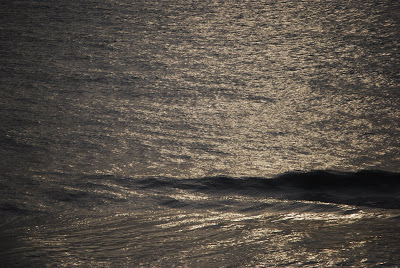
The traffic shakes us out of our reverie as we continue towards Cuddalore, an ancient port which wears the mask of an industrial town. We leave the bustling town and delve into the past. The old town presents itself, boasting of a Roman connection. But in Cuddalore, was the very foundation of the East India Company .The seas have witnessed battles fought between the arch rivals here .We skim through layers of history and learn that Fort St David, an erstwhile fort on the banks of the river Gadilam was the headquarters of the British before Fort St George in Chennai took over. A passer by tells us that this fort was under the control of the Marathas and it was later on bought over by the British . The story goes that the purchase was decided based on a shot from a gun. The area which came under the range of the canon included the entire town and Cuddalore became a British settlement.
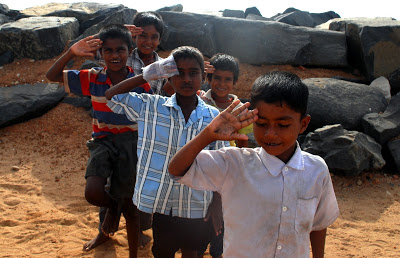
We move on as canons echo in our ears as we take another detour to enter a crowded town.“ This is where the Parangis stayed , so its called Parangipettai,” says a school teacher with whom we have a cup of tea at a local stall.” In Tamil, Europeans are called Parangis, but this small port is a trade centre for the Arabs and the Yemenis. Parangipettai or Porto Novo as it was called by the Portuguese was also colonized by the Dutch and English . I couldn’t find any ruins here, but I heard that the Nawab of Arcot minted the Porto Novo Pagoda, the gold coins from here. I leave another noisy town and move on towards Tranquebar or Tharangambadi.
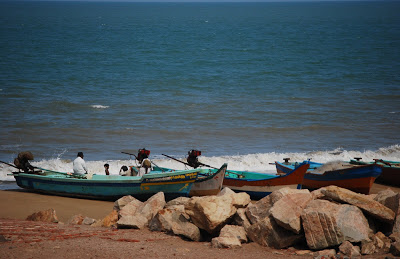
The breeze lifts our spirits. We know we are getting there. The roads get narrower as we finally get to hear the music from the sea shore. Tharangambadi means just that – the town of the singing waves. And as we walk towards the waters, the lilting tune haunts us. The waves gently stroke the rocks which seem to be a remnant of an old wall. The beach is littered with colourful boats .The nets are scattered as the kids run around. A big Indian family jump on to a boat and take pictures , while a few enjoy a swim. Couples stroll around as I watch the skies come alive with the evening colours .
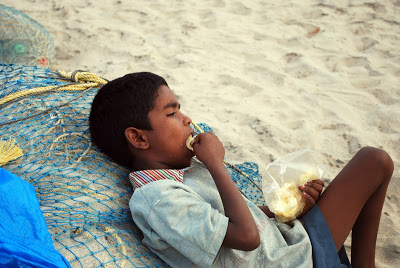
Tharangambadi or Tranquebar (Trankebar) as this Danish settlement was called found its way in the history map in the 17th century when the Danish East India company built the Fort Dansborg . Today the fort , with a Scandinavian feel about it opens out into the sea and is now a museum that tells a story of a busy port which has now become a wind blown village.
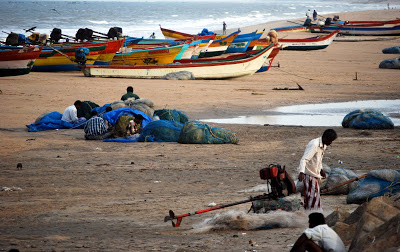
We take a heritage walk with Asai, an architect from INTACH who are doing their bit to preserve the unique architecture here which is a blend of European and Indian styles. When we enter the portals through the “ “Landporten” or the town gate, we walk into a past that has a washed out charm. The gateway sports the Danish Royal seal and leads us through a row of colonial bungalows and ancient churches.
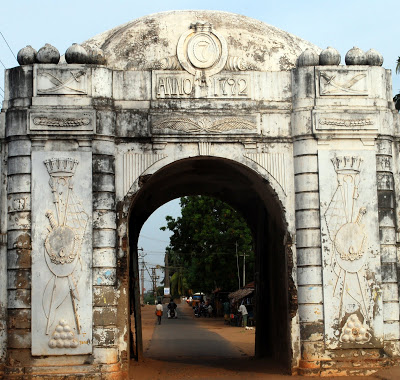
Asai takes us on a historic trail. He says that in 1620, a Danish fleet landed here and the captain identified it as a strategic trading centre. The village was then ruled by the Nayaks from Thanjavur . A deal was struck between the king, Vijaya raghunatha and the Danish admiral Ove Gjedde. A small strip of an insignificant fishing hamlet was leased from the king for an annual rent of Rs 3111 and Trankebar was created with the Dansborg Fort built right in the centre of it. While the Danes traded in spices and silks it was finally sold to the British for Rs 12.5 lakhs in 1845 .
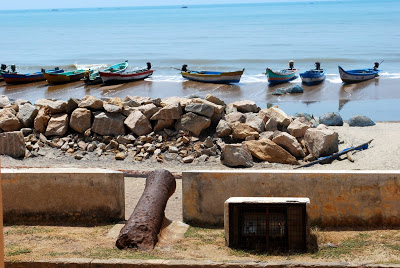
The quaint streetscapes lend an old world charm. We walk down the small bylanes called King street, Queen Street, Goldsmith Street where buildings have been restored. “To begin with the bungalows of the British Collector and the Danish Governor ,” says Asai pointing to the Bungalow on the Beach which is now a sprawling mansion overlooking the beach. “The latter is next on our agenda,” he adds.
The tsunami he says swallowed close to four streets in this lost forgotten town and he takes us to see the ravaged Masilamani Nathar temple, the oldest monument that has survived in Tranquebar, An inscription says that this partially eroded temple was built on a land granted by King Maravarman Kulasekara Pandian in 1306. The village was then referred to as Kulashekarapattinam or Thayangambadi.
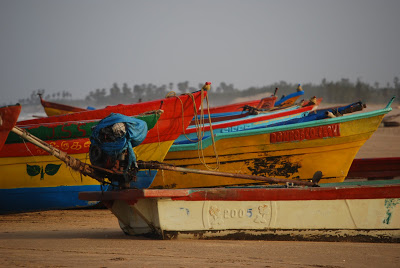
We walk with Asai to the 18th century Zion Church, the oldest protestant church of India . The New Jerusalem Church, he says was built a bit later by german missionaries Bartholomäus Ziegenbalg and Heinrich Pluetschau who translated the Bible into tamil . The trail ends near the beach as we see many tattered monuments waiting to be restored.
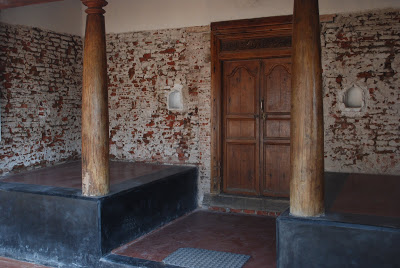
It is dusk and the melody from the waves reach a crescendo. We sit on the rocks and watch the sun set sipping a hot ginger tea when I hear a haunting tune from the past. The little snippets of history from these forgotten ports play in my mind. The passage of time may have eroded their identity and they may have slowly faded away from the political maps , but the glory of these long lost towns would probably never fade away . Its hidden , waiting to be discovered…
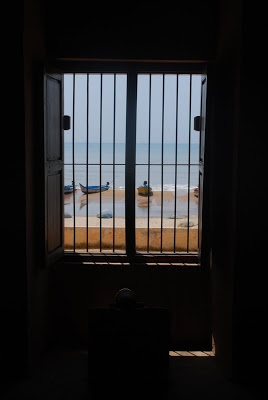
Thanks for joining me in this journey.

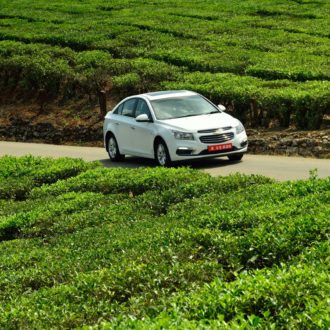
Interesting … and great pictures. I love the one of the boy lying on the sand, enjoying his potato chips.
Sounds like a very charming place.
Wow!! What a wonderful post!! Lots of information, great pictures!!! Always learning here…
Look forward to reading you at Blogtrotter!
Have a great week; we’ll be busy with the X-mas celebrations…
I have been an avid reader of your blogs and admirer of your lucid style of writing. I would request you to provide a detailed map of your journey, since it would be useful for us who are not aware of the towns in South India. I remember of similar coastal journey on Western India some years before. I would try to find their experience and send you.
Regards.
Mangesh Nabar
Lovely account of the journey, so beautifully narrated… it’s almost like being there. And God willing, sometime would like to join in on your tours.
Beatiful pictures especially the one with the children. Best regards.
What an informative, historical tour of places in our country that we hardly know or learn about! I wish you could actually write a book that details these and we could use it as a wonderful reference guide with amazing information n great pictures! Awesome post!
beautifull
Hi Lakshmi !Sorry for visiting your Blog after several months !! But i must say same amazing blog and beautiful post !!Wish you a merry Christmas and Happy New Year.
Stunning. Would love to see this part of the country.
great series of post on this coast. i think ive been to tharagambady as a kid, but hvaent managed to do it as an adult. poompuhar also is on my re-visit list. does it fall under the coromandal coast??? it has a great story to go wiht it, though there is only a meusuem in that town if i remember correctly!
Hi Lakshmi! A bit absent posting and commenting; too busy surely…
Blogtrotter has reached the January 2009 trips! Not bad; just one year delay… 😉
Enjoy, commment and enter 2010 in great shape! Wish you all the best for the New Year!!!
such beauty and warmth…
Sounds like a great place to visit. Enjoyed pictures of the sea and the kids.
I love the post (as always) 🙂
Happy New Year!
Thank you for taking me with you on this trip!
Wish you Happy New Year buddy and thanks for your concern about my health. I’m doing much fine now. will check this post series later, take care and have fun.
Hi!
I am Commodore (Retd) S Shekhar of the Indian Navy, and currently the Regional Director of the National Maritime Foundation, Chennai Chapter (www.maritimeindia.org)
I would like to compliment the author on the fascinating inputs about our rich maritime heritage on the East Coast.
Can I request the author to kindly get in touch with me at [email protected] or 09840936730 as I would like to discuss the possibilities of having these inputs published under the auspices of the National Maritime Foundation.
Best regards,
Commodore Shekhar